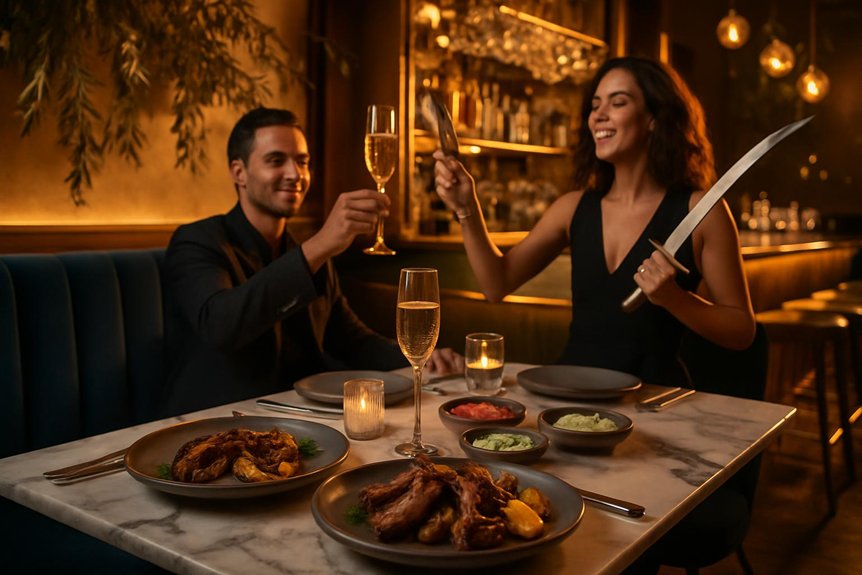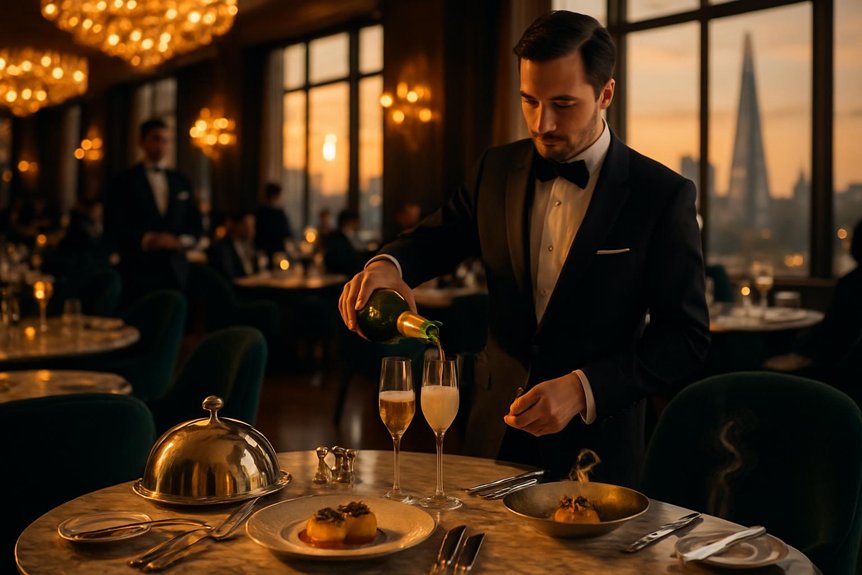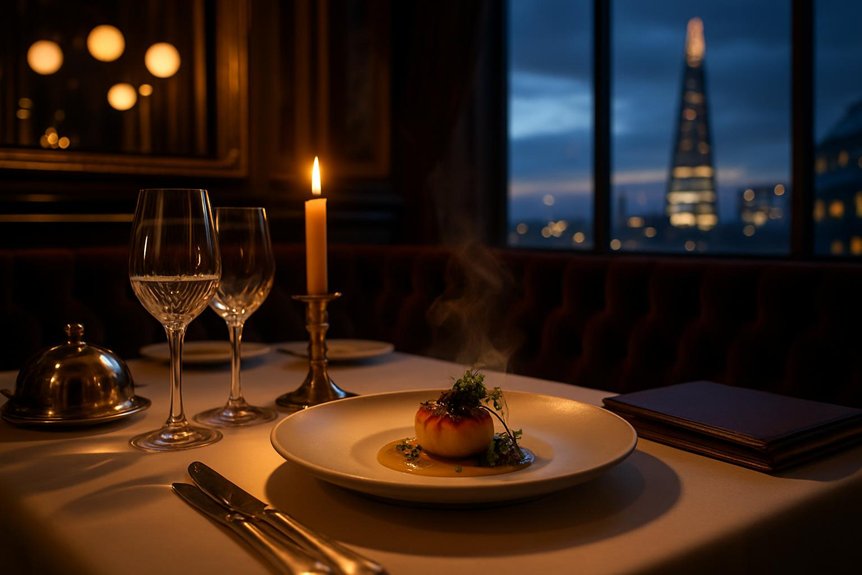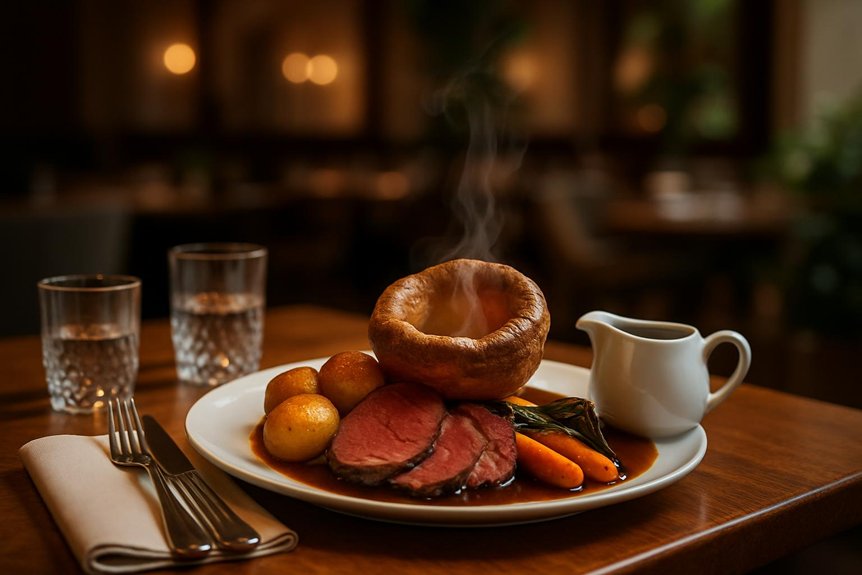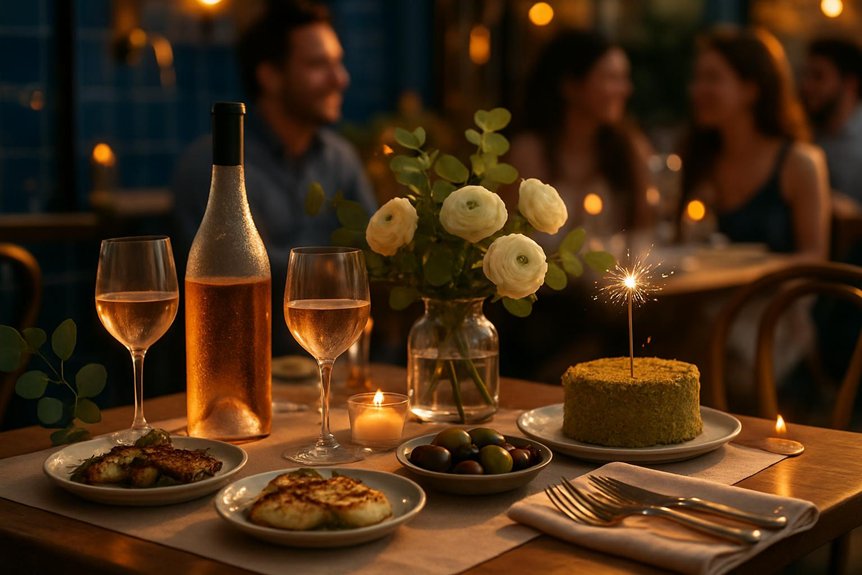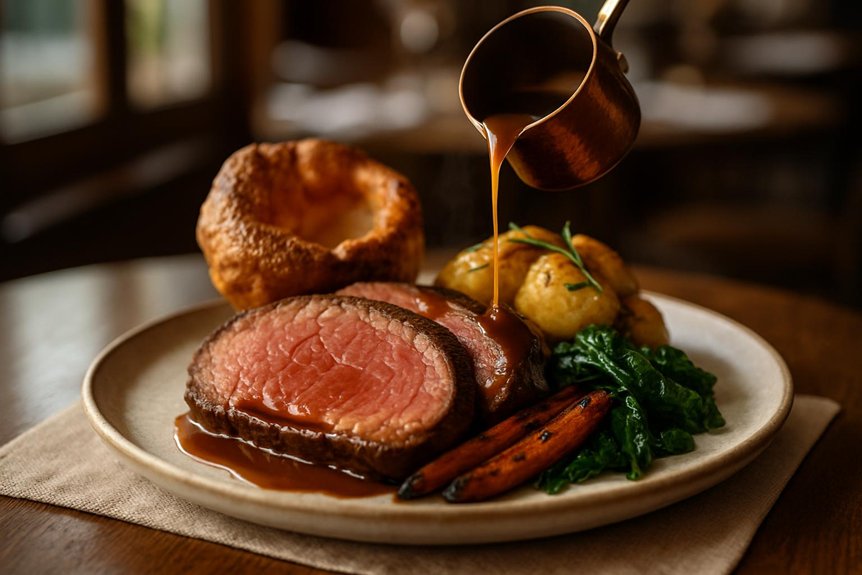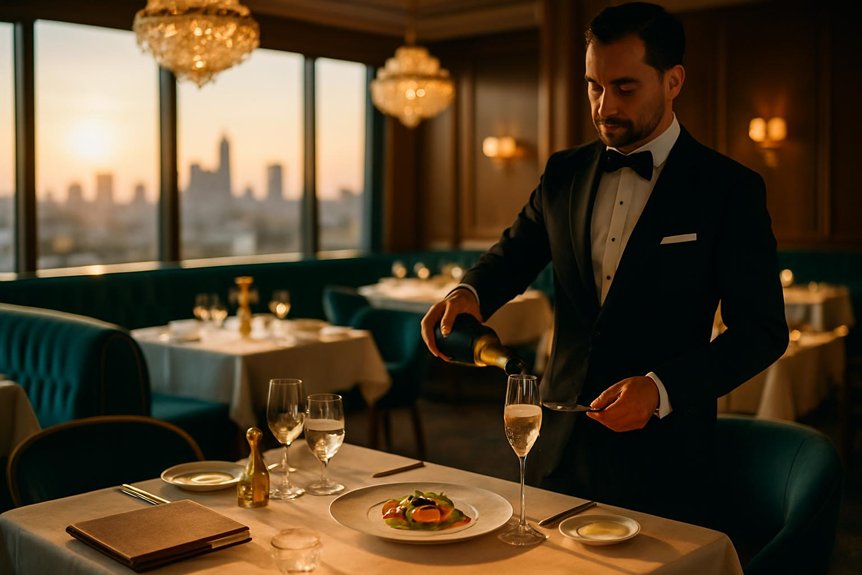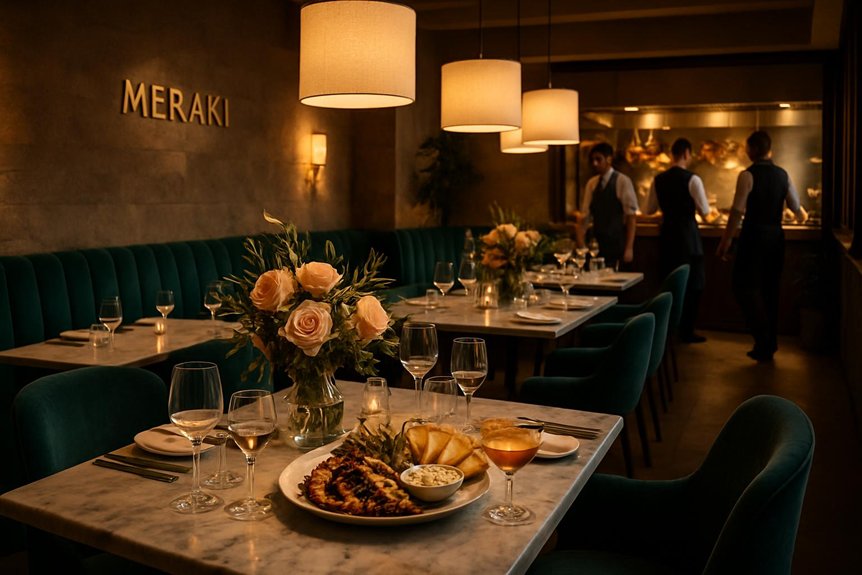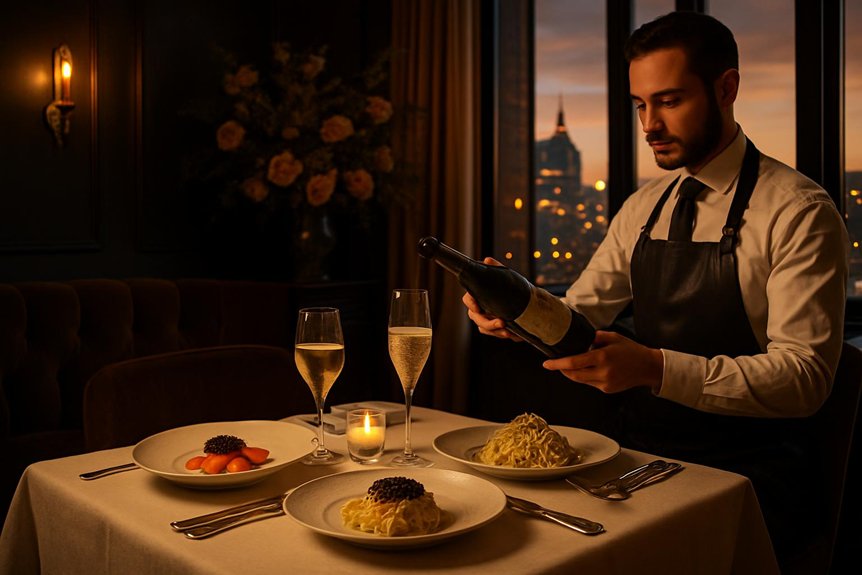London’s most exclusive dining rooms operate like quiet stages. Plates arrive as composed narratives, timing is exact, and the room’s design cues steer mood without a word. Menus shift with the week’s tide and field, while service disappears the moment it’s no longer needed. In the cellar, pairings speak through texture and structure, not price. Securing a seat is its own craft. What happens next reveals why these rituals endure.
The Allure of Culinary Theater
One unmistakable draw of London’s luxury dining is its embrace of culinary theater, where technique and presentation become part of the experience. Diners observe chefs plate with near-choreographic precision, dry ice drifting over porcelain while sauces are finished tableside. The effect is immersive, yet disciplined.
Open kitchens heighten anticipation, revealing the sequence behind smoke-infused courses, delicate carvings, and silent service cues. Fusion cuisine becomes spectacle as Japanese knifework meets French saucing, or Indian spices entwine with Nordic pickling, each gesture reinforcing narrative.
Sustainable sourcing is integrated into the performance: provenance cards, tactile displays of heirloom produce, and chefs introducing line-caught fish or biodynamic vegetables. Lighting, sound, and pacing are calibrated, so the room itself becomes stagecraft, turning dinner into a meticulously orchestrated moment. A prime example of this is Meraki in Fitzrovia, where the open kitchen and sophisticated ambiance complement the innovative twists on traditional Greek cuisine, offering diners a cosmopolitan Greek atmosphere.
Crafting Menus With Hyper-Seasonal Precision
If presentation provides the overt drama, the script is written by ingredients chosen at their fleeting peak. In London’s elite kitchens, chefs map the calendar with almost cartographic rigor, chasing micro-seasons measured in days. Menus pivot swiftly: the first pea shoots, day-boat mackerel, or chalk-stream trout dictate form, texture, and restraint. This is farm to table tightened to a metronome, where provenance is not romance but control. Producers are curated for soil, altitude, and feed; flavor is the metric. Saucing is lighter, temperatures lower, and plating calibrated to keep volatility intact. A course might hinge on a single herb, then resolve through a farmstead pairing: raw-milk cheese echoed by orchard fruit. Waste is minimized, batches remain small, and creativity follows the harvest’s clock. At Meraki, the culinary philosophy emphasizes the freshness and vibrancy of Mediterranean ingredients, blending traditional roots with innovative techniques.
Service as an Invisible Art
Though the room hums with quiet choreography, service here recedes by design. Attentiveness is calibrated to vanish at the moment it is felt, a discipline refined through timing, silence, and an almost telepathic read of the table. Glasses refill without request; plates arrive and leave with the grace of blind service, minimizing interruption while maintaining momentum. The effect is not showmanship but assurance: guests sense control without spectacle.
- Course pacing synced to conversation, not the clock
- Blind service that clears and sets as if by afterthought
- Personalized touches informed by unobtrusive observation
- Discreet leadership that anticipates exceptions
Menus speak; staff interpret. Preferences are recorded, remembered, and quietly enacted on return visits. The guest’s narrative stays central, while technique withdraws into the background, precise yet nearly invisible. The smart dress code is enforced to enhance the stylish and enjoyable environment, ensuring guests feel a part of the vibrant atmosphere.
Design That Shapes the Dining Mood
Lighting sets the emotional tone, from candlelit intimacy to crisp, gallery-like brightness.
Materials and textures—polished marble, brushed brass, supple leather, raw linen—shape tactile expectations and acoustic warmth.
Together, these choices guide pace, conversation, and the sense of occasion.
Lighting and Ambience
Few elements influence a luxury dining room more decisively than its light. In London’s finest rooms, lighting design orchestrates tempo, intimacy, and focus, guiding the eye from entrance to plate.
Designers layer sources—pendants, sconces, concealed LEDs—to balance glow and shadow, while dimming curves shift seamlessly from aperitif brightness to dessert hush.
Ambience enhancement is achieved by tuning color temperature and beam spread so faces look natural and dishes gleam without glare. Sightlines are kept clean; fixtures disappear, effect remains.
- Candlelike warmth at tables fosters privacy without sacrificing clarity.
- Accent beams sculpt centerpieces and art, creating subtle focal points.
- Intelligent controls map scenes to service rhythm and seasonal light.
- Reflections are minimized; luminance contrasts stay comfortable and calm.
Materials and Textures
As light sets tempo, surface does the talking. In London’s luxury dining rooms, materials choreograph mood with quiet authority. Marble and honed stone cool the palette; oiled oak and walnut warm it.
The texture of fabrics—linen with crisp grain, velvet with low pile—modulates acoustics and tactility, encouraging conversation at a measured pace. Metal accents, whether aged brass or matte nickel, catch glints without glare, guiding the eye toward plated compositions.
Tableware quality anchors the narrative. Thin-rimmed crystal amplifies aroma; high-fired porcelain preserves heat and defines edges; hand-thrown ceramics provide organic counterpoint to precision cuisine. Leather-bound menus, patinated mirrors, and soft underfoot rugs complete the sensory layering.
Every surface signals intent: restraint, generosity, and craft aligning to heighten the dining experience.
Cellars, Pairings, and the Language of Wine
London’s most rarefied tables often anchor the experience with curated Old-World cellars, where vintages are selected for provenance and restraint.
Sommeliers guide pairings course by course, calibrating acidity, texture, and terroir to the chef’s intent.
Guests are introduced to a precise tasting vocabulary—minerality, structure, finish—that turns perception into shared understanding.
Curated Old-World Cellars
A curated Old-World cellar anchors luxury dining with bottles chosen for provenance, vintage integrity, and stylistic typicity. In London’s finest rooms, the narrative begins below street level, where Historical wine collections rest under controlled darkness, humidity, and silence.
Underground storage techniques maintain stability, allowing fragile aromatics and textures to mature without compromise. Directors of wine prioritize estates with documented lineage, benchmark crus, and judicious reconditioning.
- Rare verticals that trace decades of climate and craft
- Estates selected for typicity across terroirs and appellations
- Meticulous cataloging, provenance checks, and condition reports
- Discreet decanting protocols and service temperatures by style
The cellar’s grammar is regional: Burgundy’s tension, Barolo’s architecture, Rioja’s patience, the Loire’s precision.
Labels serve as reference points, not trophies, preserving authenticity and enhancing a restaurant’s cultural memory.
Sommelier-Guided Pairings
How does a sommelier translate a cellar’s quiet authority into flavor on the plate? In London’s highest temples of dining, the sommelier listens first: to the chef’s intention, to seasonality, to the tempo of service.
He or she then narrows candidates by structure—acidity, tannin, alcohol, texture—before consulting provenance and vessel materials that shaped the wine’s contour: amphora for grip, concrete for neutrality, oak for spice and breadth.
Pairings are proposed with spare, precise wine terminology that orients the guest without digression: saline, linear, plush, lifted.
A turbot fillet might meet a Chablis aged in steel for clarity; venison might receive a whole-cluster Côte-Rôtie for aromatic drive.
The sommelier calibrates temperature, decanting, and pour size, ensuring each course resolves with balance and momentum.
Decoding Tasting Vocabulary
From the choreography of pairings emerges a vocabulary that guides choices as much as it describes them. In London’s elite dining rooms, precision in language links cellar depth to the plate. Terms like structure, minerality, and grip signal how wines behave with fat, acid, and umami. Clear tasting notes translate complexity into usable cues: citrus lift for oysters, graphite and cassis for venison, brioche and autolysis for caviar.
- Decode flavor profiles: fruit ripeness, acidity, tannin shape, and texture.
- Map terminology to dishes: saline whites with shellfish, earthy reds with mushrooms.
- Read cellar cues: region, vintage, and producer style refine expectations.
- Calibrate service: glassware, temperature, and aeration adjust expression.
The lexicon becomes a tool, turning preference into deliberate, confident selection.
Securing the Most Coveted Tables
Why do certain London dining rooms feel as elusive as a gallery’s private viewing? The answer often lies in timing, relationships, and precision. A table reservation at marquee addresses opens weeks ahead, and peak slots vanish within minutes. Guests who monitor release windows, use concierge services, and confirm promptly fare better.
Hosts note concise requests and flexibility: early evening, late seating, or counter spots. A respectful acknowledgement of the dress code signals compatibility with the house’s standards.
Leverage quiet nights—Monday or late Sunday—and watch cancellation lists, which move quickly after 3 p.m. Social capital matters: polite follow-ups, not pressure, earn goodwill. Regulars build credibility through consistent visits and punctuality.
For special occasions, communicate succinctly and verify details 24 hours prior to reduce surprises.
Conclusion
In London’s finest rooms, luxury dining reveals itself as choreography: kitchens composing hyper-seasonal narratives, service gliding invisibly, design tuning light and hush to appetite. One telling figure underscores the obsession—some Michelin kitchens log more than 120 micro-adjustments per service, from sauce viscosity to plate temperature—each tweak amplifying intent. Add cellars speaking in terroir and texture, and reservation strategies worthy of chess, and the meal becomes memory’s architecture, a distilled performance where precision warms into pleasure.

